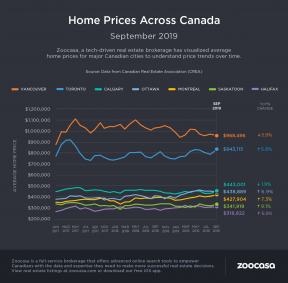The Canadian housing market continues to strengthen throughout the autumn, as sales and prices experienced solid gains in September, according to the Canadian Real Estate Association.
Housing activity rose for the seventh month in a row, up a robust 15.5% from the same month in 2018, and 0.6% from August. The average sale price increased 5.3% year over year to $515,500 (though removing Greater Vancouver and Toronto real estate from the equation would reduce the national average to $397,000). The MLS Home Price Index, which measures the overall value of homes sold, also edged up 1.3% annually, the largest year-over-year increase recorded since December 2018.
Most Urban Markets Experienced Improvement in Sales
Overall, September sales clocked in 18% higher than the low recorded this past February, though remain 8% below the peak experienced in 2016 and late 2017. Compared to last year’s particularly slow September, the numbers appear especially impressive; however, the uptick was noted in more than half of all the local markets tracked by CREA, especially in the Greater Vancouver MLS and Fraser Valley – signs these markets continue to stabilize from their steep tumble this winter.
Sales also rose in the Edmonton, Winnipeg, the GTA, Hamilton-Burlington, Ottawa, Montreal, and Calgary real estate markets.
CREA Chief Economist Gregory Klump says the stage is set for continued growth across the country, though external economic factors, such as international trade uncertainty, could pose risks.
“Home sales activity and prices are improving after having weakened significantly in a number of housing markets,” he stated. “How long the current rebound continues depends on economic growth, which is being subdued by trade and business investment uncertainties.”
A National Sellers’ Market
Overall, the national housing market is leaning slightly in favour of sellers, as the supply of new listings brought to market during the month shrank by -0.6%. Combined with the uptick in sales, that has led to an increased sales-to-new-listings ratio (SNLR) of 61.3%, indicating a sellers’ market, and above the long-term average of 53.6%.
This ratio, which measures the level of buyer competition in a market, is calculated by dividing the number of sales by the number of new listings over the course of the month; a percentage between 40 – 60% indicates a balanced market, with below and above that threshold signalling buyer and seller-friendly conditions, respectively.
According to CREA, the GTA and Lower Mainland of Vancouver remain in balanced territory with the rest of markets in sellers’ conditions, with the exception of Saskatoon and east-Saskatchewan, which are buyers’ markets.
Months of Inventory Remain Below Average
The total months of national inventory – a measure that indicates how long it would take to completely sell all available homes for sale – also remains well above the long-term average at 4.3 months, the lowest level since December 2017. However, this remains highly varied in local markets across the country – inventory is much lower than the long term average in Ontario, Quebec, and the Maritimes, priming these provinces for “fertile price gains”, and well above the average in the Prairies and Newfoundland and Labrador. BC’s Lower Mainland remains balanced, indicating sales and prices will continue to stabilize.
Price Growth Varies Between Eastern and Western Canada
While CREA notes that prices are stabilizing somewhat in the slowest markets, the gap between eastern and western provinces remains significant. Price growth has been strong throughout the Greater Golden Horseshoe and further east markets, while BC, Alberta, and Saskatchewan are seeing much softer performance.
In BC, home prices remain below last year’s levels in the Greater Vancouver and Fraser Valley markets, but the declines have slowed compared to recent months, down -7.3% and -4.8%, respectively. Prices rose slightly by 0.4% in Vancouver Island and 1.1% in the Okanagan Valley, and rose 0.4% in Victoria.
Prices across the Prairies fell between 1 – 4% year over year, while the GGH experienced growth well ahead of inflation. Strong price growth continued uninterrupted in Ottawa, Montreal, and Moncton.
All Home Types Saw September Price Gains
For the second month in a row, all home types saw an increase in priced growth, with the strongest improvement in the two-storey single-family home segment, which rose 1.7% year over year. That was followed by 1.4% growth in the one-storey single-family segment, while townhouse and condo prices both rose 0.4% and 0.7%, respectively.
Check out the infographic below to see how home prices performed in major markets across Canada in September.
CREA : Canadian Home Sales Rise for Seventh Consecutive Month in September by Penelope Graham | zoocasa



Recent Comments